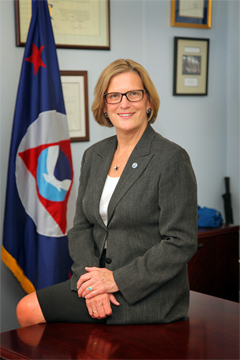[SatNews] NOAA’s FY 2016 budget request of nearly $6.0 billion supports critical investments in our priorities, including: 1) community and economic resilience; 2) National Weather Service (NWS) evolution; 3) observational infrastructure; and 4) organizational excellence.

Dr. Kathryn Sullivan,
NOAA Administrator.
The FY 2016 budget request will improve NOAA’s ability to provide people, communities, businesses, and governments with information they can understand and use to make smart decisions, assess risk, and minimize losses. With the foresight provided through environmental intelligence, communities can mitigate coastal flooding through natural shorelines, fisheries can better account for changing ocean temperatures and acidification, and different economic sectors can position themselves to take advantage of our changing climate. The proposed expansion of the Regional Coastal Resilience Grants program will empower states, territories, tribes, local government, and public/private partners to improve resilience planning efforts, identify and address their shared risks and vulnerabilities, increase their adaptive capacity, and use tools such as “green infrastructure” to mitigate and minimize the risks associated with climate impacts.
Impacts from severe storms in the United States cost billions of dollars and claim thousands of lives per year. Becoming a Weather Ready Nation means not just providing timely, accurate, and reliable weather forecasts, but it also means communicating that information in a way that compels people to act to protect themselves and their interests. The FY 2016 budget will continue efforts already underway to evolve the National Weather Service. Major activities in FY 2016 include overhauling the aging Next Generation Weather Radar infrastructure that underpins our weather forecast and warning services for high-impact events, such as tornadoes. In addition, this request builds on the FY 2015 initiative to improve national hydrologic modeling and forecast capabilities at the National Water Center, which are essential to providing communities improved flood forecasts and inundation mapping. The FY 2016 budget also includes an initiative to improve skill in forecasting weather out to weeks three and four—a time period which is currently poorly forecasted and for which many economic sectors are demanding better insight into probable climate and economic conditions.
NOAA’s global observing systems are the foundation of the environmental intelligence we provide. The FY 2016 budget includes critical investments in weather satellite systems and the NOAA fleet to preserve—and improve—our ability to generate environmental intelligence. The FY 2016 budget begins a polar follow-on satellite system to ensure data continuity for key sensors as the current generation of satellites reaches their end of service. The FY 2016 budget also initiates construction of an Ocean Survey Vessel (OSV), a multi-use platform designed to conduct surveys throughout the U.S. Exclusive Economic Zone. The OSV will have a more diverse range of capabilities and functions than any other vessel in the NOAA fleet. Without continued investment, the NOAA fleet is expected to decline to half its current size by 2028, which would impair NOAA’s ability to provide the observations and services that communities depend on.
Each day, NOAA’s employees strive to promote organizational excellence and execute our mission with discipline and consistency. We must recruit, retain, reward, and develop the best talent possible and ensure that our customers receive the best service possible. The FY 2016 budget continues critical investments in organizational excellence by bolstering our internal servicing capability and efficiency and investing in the future of NOAA’s facilities. These services and facilities are the cornerstone of NOAA’s ability to effectively execute its mission of science, service, and stewardship.
In closing, NOAA’s FY 2016 budget submission supports our unique role within the federal government. The investments we make today are critical as we strive to provide the environmental intelligence communities have come to rely upon.
For further information regarding NOAA, please visit the agency's infosite at http://www.noaa.gov/index.html
The preceding was a statement made by
Dr. Kathryn Sullivan
Under Secretary of Commerce for Oceans and Atmosphere
and NOAA Administrator